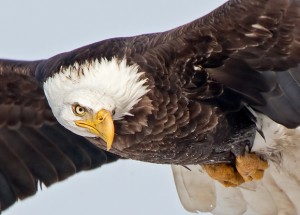We have much more to do and your continued support is needed now more than ever.
4 New Insights for Climate-Smart Conservation
Resource managers and conservation practitioners work to preserve, protect, and understand the lands, waters, and wildlife of our country. What do these professionals need in order to address the challenges posed by climate change in their work? We spent a year asking 195 natural and cultural resource managers, conservation practitioners, and researchers this question.
These professionals work along the west coast of North America in the North Pacific Landscape Conservation Cooperative (NPLCC) region. This is a dynamic and beautiful place filled with dense evergreen forests, spectacular coastlines, some of America’s longest rivers, and such iconic species as salmon, orca, and grizzly bear. While their toolbox is full of strategies and actions applied over the decades, they requested more support to address the particular challenges presented by climate change.
Decision-support systems and tools
By gathering the most relevant documents, data, and other resources in one place, decision-support systems and tools enable managers and decision makers to make more informed decisions. For the managers, conservation practitioners, and researchers we engaged, decision-support systems and tools were the most requested type of support. These systems and tools may include:
- Maps showing where a particular type of habitat is located
- Climate change vulnerability assessments for a specific forest, beach or other location
- Computer- or web-based tools that visualize climate change impacts, alternative ways to respond to impacts, and the pros and cons of choosing one alternative over another
Collaboration and other capacity-building activities
The NPLCC region traverses the Pacific coastline from southern Alaska to northwest California. It crosses state and national boundaries and encompasses federal, tribal, state, and non-governmental jurisdictions. As such, the professionals we engaged emphasized the need to pursue projects and plans that meet the objectives of multiple partners working to address climate change effects on diverse ecosystems. They also emphasized the need to work together to maintain or improve the health and status of the region’s ecosystems over time; in other words, to build or maintain landscape resilience over time. Requested capacity-building activities include:

- Guidance such as “Best Management Practices” manuals that outline how to incorporate climate change considerations into planning efforts. Or, assessments of the pros and cons of applying new or controversial research to make management decisions.
- Case studies of progress or success in climate change adaptation
- Development of synthesis products, such as an assessment of when, where and under what conditions to use tools for climate change analyses and/or planning. Or, a web-based “climate clearinghouse” that compiles contact information, scientific literature on climate change, and/or an inventory of existing research.
- Facilitation of collaboration among people, projects, institutions, and funding sources
New or different science, data and information
Some data gaps and information needs identified by the managers, conservation practitioners, and researchers we engaged are shared throughout the NPLCC region, while others are particular to a specific location or ecosystem.

- Hydrologic data (i.e., water data) in Alaska and British Columbia such as data on how much water flows in a stream per year, per season, per month, or per day.
- Regional and local models of ocean conditions. These may include water temperature, patterns of ocean currents, the level of nutrients in the water, and other conditions.
- Scenarios of climate and socioeconomic conditions, developed in collaboration with decision makers and stakeholders. Scenarios are different but equally possible “visions of the future.” They provide specific descriptions of what the future will look like based on hypothetical (or in some cases, real) decisions made today.
Science communication and outreach
The professionals we engaged identified three audiences for targeted communication and outreach: resource managers, conservation practitioners, and researchers; the public and educators; and, decision makers. They also emphasized that promoting effective science communication and outreach will require targeted messaging and a user-to-consumer approach. Examples of requested communication and outreach needs and activities include:
- Use of visualization tools to communicate climate change effects and examine potentially vulnerable areas
- Making the connection between social, economic, and ecological impacts, especially when communicating with decision makers and the public
Learn more and support our work to build capacity to address climate change
Download the full report: Advancing Landscape-Scale Conservation: An Assessment of Climate Change-Related Challenges, Needs, and Opportunities for the NPLCC (pdf)
Learn more about our work to build capacity to address climate change
Take action in the Pacific Region






















